What Are Deserts?
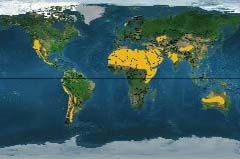 Deserts cover about a fifth of the Earth's surface. Deserts have extreme environments. They get 1-15 inches of precipitation per year. Desert plants and animals have special adaptations that help them survive in this extreme environment. Most people think of deserts as being hot and dry, but some deserts are actually cold! There are four types of deserts: subtropical deserts are hot and dry year-round; coastal deserts have cool winters and warm summers; cold winter deserts have long, dry summers and low rainfall in the winter; polar deserts are cold year-round. Deserts cover about a fifth of the Earth's surface. Deserts have extreme environments. They get 1-15 inches of precipitation per year. Desert plants and animals have special adaptations that help them survive in this extreme environment. Most people think of deserts as being hot and dry, but some deserts are actually cold! There are four types of deserts: subtropical deserts are hot and dry year-round; coastal deserts have cool winters and warm summers; cold winter deserts have long, dry summers and low rainfall in the winter; polar deserts are cold year-round.
Subtropical Deserts
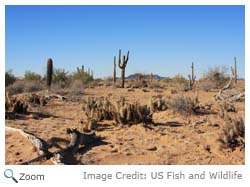 Subtropical deserts are the hottest deserts. They are found in Asia, Australia, Africa, and North and South America. In the United States, the Chihuahuan, Sonoran, and Mojave are all subtropical deserts. Subtropical deserts are very hot and dry in the summer and cooler, but still dry, in the winter. Rainfall happens in short bursts. The air is so hot and dry in these deserts that sometimes rain evaporates before it even has a chance to hit the ground! The soil in subtropical deserts is usually either sandy or coarse and rocky. Subtropical deserts are the hottest deserts. They are found in Asia, Australia, Africa, and North and South America. In the United States, the Chihuahuan, Sonoran, and Mojave are all subtropical deserts. Subtropical deserts are very hot and dry in the summer and cooler, but still dry, in the winter. Rainfall happens in short bursts. The air is so hot and dry in these deserts that sometimes rain evaporates before it even has a chance to hit the ground! The soil in subtropical deserts is usually either sandy or coarse and rocky.
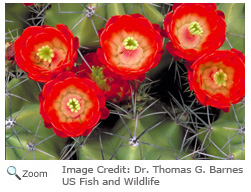 Plants and animals in subtropical deserts must be able to withstand the hot temperatures and lack of moisture. Shrubs and small trees in the subtropical desert usually have leaves adapted to retain moisture. Animals in subtropical deserts are usually active at night, when it is cooler. Plants and animals in subtropical deserts must be able to withstand the hot temperatures and lack of moisture. Shrubs and small trees in the subtropical desert usually have leaves adapted to retain moisture. Animals in subtropical deserts are usually active at night, when it is cooler. |
|
Coastal Deserts
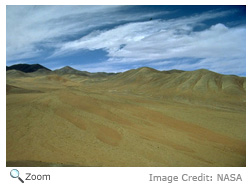 Coastal deserts occur in cool to warm areas along the coast. They have cool winters and long, warm summers. Coastal deserts are located on the west coasts of continents at latitudes of 20° - 30°. Winds off the coast blow in an easterly pattern and prevents the moisture from moving onto the land. The Namib Desert in Africa and the Atacama Desert in Chile are coastal deserts. Coastal deserts occur in cool to warm areas along the coast. They have cool winters and long, warm summers. Coastal deserts are located on the west coasts of continents at latitudes of 20° - 30°. Winds off the coast blow in an easterly pattern and prevents the moisture from moving onto the land. The Namib Desert in Africa and the Atacama Desert in Chile are coastal deserts.
Cold Winter Deserts
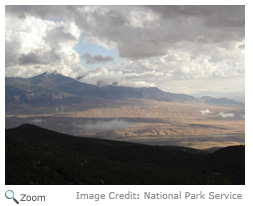 Cold winter deserts are also known as semi-arid deserts. They have long, dry summers and cold winters with low rain or snowfall. In the United States, the Great Basin, the Colorado Plateau, and the Red Desert are all cold winter deserts. Other cold winter deserts include the Gobi desert in China and Mongolia and the Patagonian desert in Argentina. The lack of rainfall in cold winter deserts is often caused by the rainshadow effect. The rainshadow effect happens when a high mountain range stops moisture from reaching an area. The Himalayan Mountains prevent rainfall from reaching the Gobi Desert. Cold winter deserts are also known as semi-arid deserts. They have long, dry summers and cold winters with low rain or snowfall. In the United States, the Great Basin, the Colorado Plateau, and the Red Desert are all cold winter deserts. Other cold winter deserts include the Gobi desert in China and Mongolia and the Patagonian desert in Argentina. The lack of rainfall in cold winter deserts is often caused by the rainshadow effect. The rainshadow effect happens when a high mountain range stops moisture from reaching an area. The Himalayan Mountains prevent rainfall from reaching the Gobi Desert.
Polar Deserts
Polar desert are found in the Arctic and Antarctic regions. Like warmer deserts, they also get very little precipitation.
|